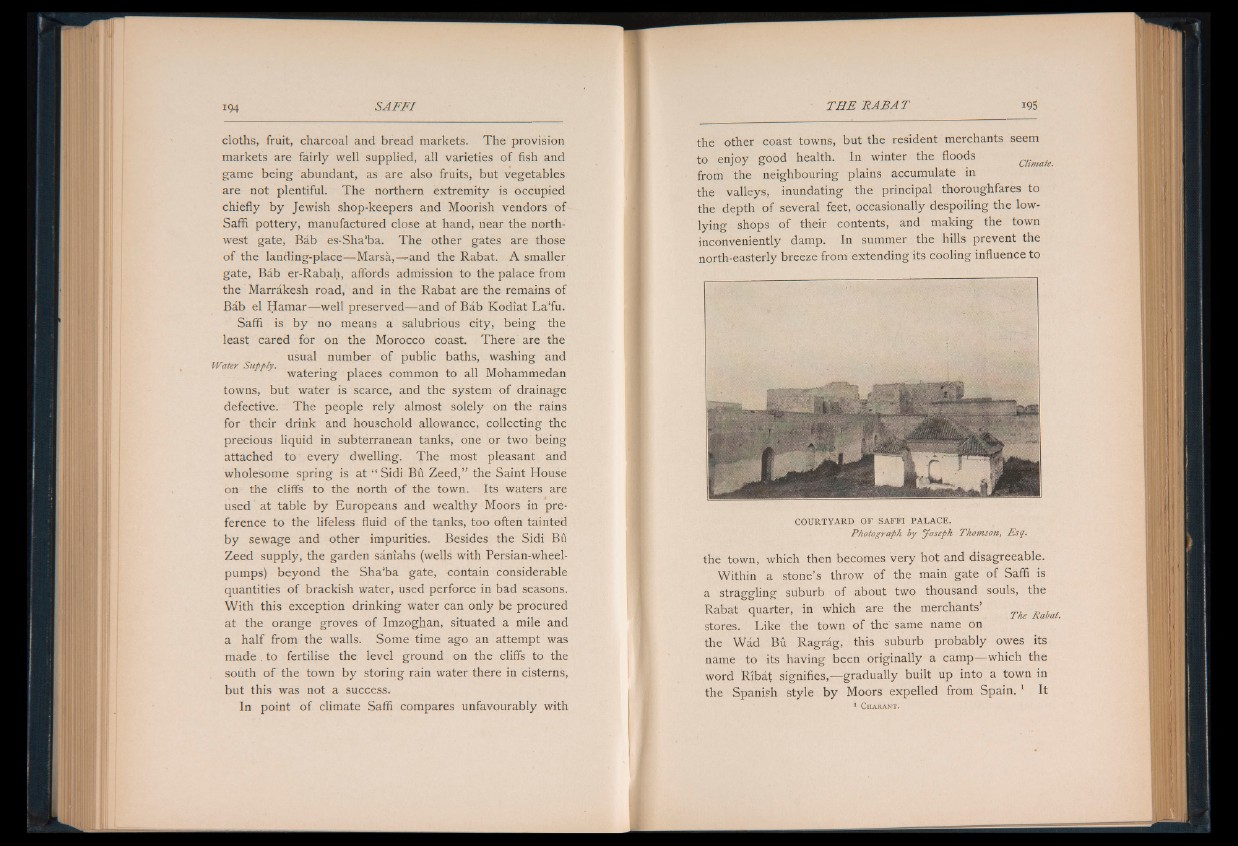
cloths, fruit, charcoal and bread markets. The provision
markets are fairly well supplied, all varieties of fish and
game being abundant, as are also fruits, but vegetables
are not plentiful. The northern extremity is occupied
chiefly by Jewish shop-keepers and Moorish vendors of
Saffi pottery, manufactured close at hand, near the northwest
gate, Bab es-Sha'ba. The other gates are those
of the landing-place— Marsa,^-and the Rabat. A smaller
gate, Bab er-Rabah, affords admission to the palace from
the Marrakesh road, and in the Rabat are the remains of
Bab el Hamar|j|well preserved— and of Bab Kodiat L a ‘fu.
Saffi is by no means a salubrious city, being the
least cared for on the Morocco coast. There are the
usual number of public baths, washing and
Water Supply. .
watering places common to all Mohammedan
towns, but water is scarce, and the system of drainage
defective. The people rely almost solely on the rains
for their drink and household allowance, collecting the
precious liquid in subterranean tanks, one or two being
attached to every dwelling. The most pleasant and
wholesome spring is at “ Sidi Bu Zeed,” the Saint House
on the cliffs to the north of the town. Its waters are
used at table by Europeans and wealthy Moors in preference
to the lifeless fluid of the tanks, too often tainted
by sewage and other impurities. Besides the Sidi Bu
Zeed supply, the garden saniahs (wells with Persian-wheel-
pumps) beyond the Sha'ba gate, contain considerable
quantities of brackish water, used perforce in bad seasons.
With this exception drinking water can only be procured
at the orange groves of Imzoghan, situated a mile and
a half from the walls. Some time ago an attempt was
made . to fertilise the level ground on the cliffs to the
south of the town by storing rain water there in cisterns,
but this was not a success.
In point o f climate Saffi compares unfavourably with
the other coast towns, but the resident merchants seem
to enjoy good health. In winter the floods climate
from the neighbouring plains accumulate in
the valleys, inundating the principal thoroughfares to
the depth of several feet, occasionally despoiling the low-
lying shops of their contents, and making the town
inconveniently damp. In summer the hills prevent the
north-easterly breeze from extending its cooling influence to
COURT YARD OF SAFFI PA LA C E .
Photograph by Joseph Thomson, Esq.
the town, which then becomes very hot aud disagreeable.
Within a stone’s throw of the main gate of Saffi is
a straggling suburb of about two thousand souls, the
Rabat quarter, in which are the merchants’
stores. Like the town of the same name on
the Wad Bu Ragrag, this suburb probably owes its
name to its having been originally a camp— which the
word Ribat signifies,— gradually built up into a town in
the Spanish style by Moors expelled from Spain. 1 It
1 C h a r a n t .